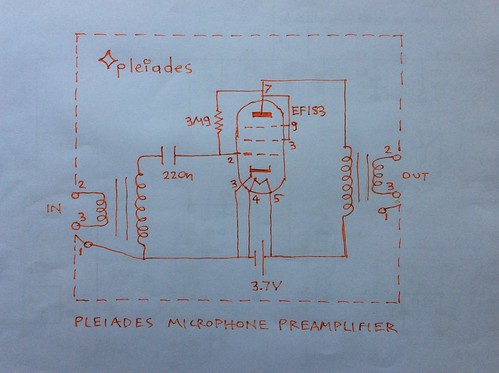Summary:
Supply voltage for both heaters and anode was 3.9V. A Pleiades bias resistor or approx. 2MΩ to 6MΩ was used from anode to grid. The electron tube operated beautifully revealing ambient sound from many rooms away. Without Pleiades bias there was no sound at all as the electron tube current is cutoff. When a 2MΩ resistor was returned to cathode (ground) there was sound, low gain, some hiss extremely low anode current and reduced bandwidth. It was nevertheless an interesting sound but hiss was objectionable.
Main post:
The schematic used is the Pleiades V6:

A 22nF MkT coupling capacitor was used.
The EF183 was removed from the Pleiadss experimental breadboard jig and a 7586 Nuvistor was connected by inserting the flying leads soldered to a Cinch base.
The usual setup is:
Male singing voice - Grampian DP4/L (25Ω) - Pleiades V6 with 3.9V - Sony TC-D5 Pro switched to mono XLR mic input - Sennheiser HD 580
Before connecting the Nuvistor the EF183 was auditioned. Tye sound was great as usual. The anode current about 50μA. There is a few ohm series heater resistor supplying heaters with less then 3.9V. It was kept in circuit.
The Nuvistor was supplied with power. Initially there was frustration as there was no sound at all. But there was hiss indicating the amplifier was operating. It turned out to be a bad contact on the input transformer base.
The sound came beautifully. It reminded Motown richness and EQed mid high detail. A very natural sound to listener's ear brain.
At exactly the same conditions of 3.9V supply voltage including the anode and 6MΩ Pleiades bias resistor from anode to grid the anode current of the 7586 is 25μA ie half that of the EF183 anode current. (On the EF183 the anode is connected to screen grid to suppressor grid. Most electrons are collected by the screen grid which is much closer to cathode and control grid. Additionally the EF183 is a vari μ electron tube).
Then a 2.7MΩ resistor was connected in parallel with the 6MΩ resistor. So a total of 2MΩ?
The anode current jumped to 50μA. The sound changed to sounding more treble detailed. More like Endless Love - Lionel Richie, Dianna Ross.
The Nuvistor head amplifier on both bias cases is very low noise and revealing. A rather loud ticking clock many feet away in a different room could be clearly heard through headphones together with other ambient sounds from everywhere including a Motown CD playing at very soft volume in a room even further away. (Pleiades 2N3053 - Philips AD5046N setup).
Outdoor sounds could be heard through double windows. The sensitivity reminded a lot the AKG C12A condenser microphone using the same Nuvistor electron tube type. It is a joy waiting for the electron tube to warm up and gradually there comes full ambience from everywhere.
Switching back to EF183. The EF183 has more gain and more bandwidth. But this somehow made it sound more bass heavy and confused in comparison. When 2MΩ was connected the current jumped to 120μA and there was a comparable increase in high frequency tightness.
Turning back to Nuvistor 7586 the sound is somewhat more defined. The bad component of room acoustics is possibly less revealed. The realism and definition of voice is impressive. 6MΩ gives a bigger easier, less tight sound.
When disconnecting the Pleiades bias resistor from anode there was no anode current and no sound at all. This is expected as the grid becomes biased at around -700mV by the boiling electrons from cathode. See previous posts.
When returning the 2MΩ to grounded cathode (the cathode is positive by missing electrons) there was some sound and a very low anode current, the μA needle slightly moving. The sound was interesting as there was less bandwidth and this may be suitable for some songs. But there was hiss and the far away clock could be heard at the same proportion as hiss.
Conclusion:
Very high quality and low noise head or front end microphone amplifiers are possible with Nuvistors operating with just 4V and Pleiades bias. The sound is world class and power consumption is even less than using an undeheated EF183. So far EF183, ECC82, 7586 sound great at less than 6V anode voltage and biasing from anode to grid. Other electron tubes worth experimenting can be 6SK7, EF37A etc. Switching off underheating voltage on the 7586 made the sound disappear quicklier than the EF183. Further reducing the anode voltage to say 1.5V has not been yet attempted. It may be an interesting experiment making way for possible use of the 2DS4 electron tube with just one 1.5V battery. So far the electrometer CV2269 is operated with 1 AAA battery with great sound but little hiss on the Pleiadss V1 microphone preamplifier.
No comments:
Post a Comment